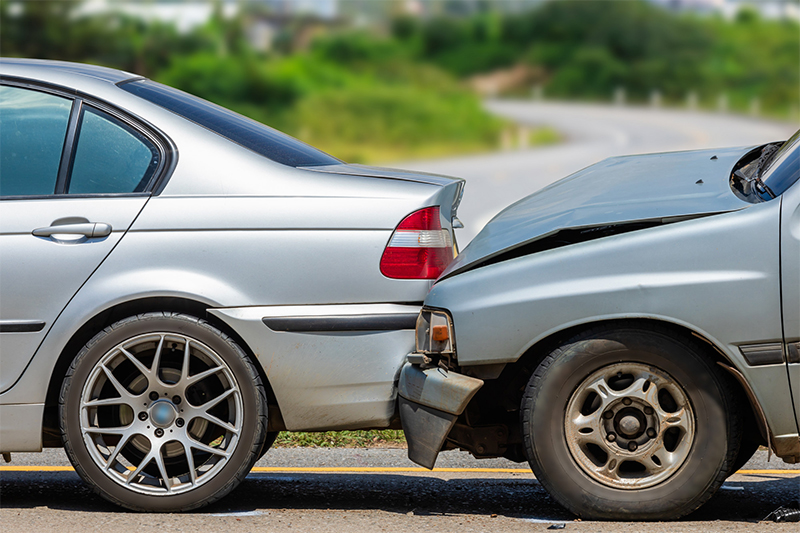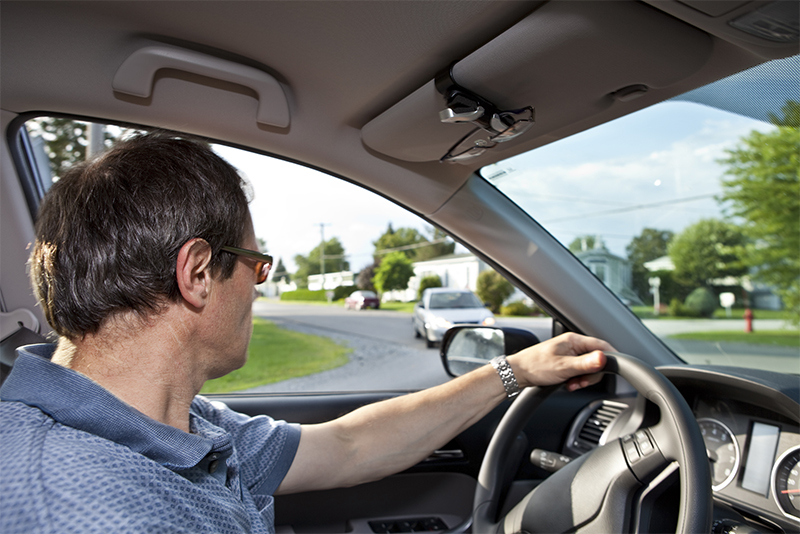Driving Errors That Cause Accidents
Navigating Oregon’s roads requires diligence and adherence to traffic laws. However, even the most experienced drivers can sometimes make errors that compromise safety.
In this blog, we explore the top 10 driving errors commonly observed on Oregon’s roadways. From speeding to distracted driving, we will understand why Oregon is considered 24th nationally for car accident fatalities per capita, up from 33rd in 2022.
Here’s a list of the top 10 reasons behind driving accidents in Oregon, backed by research. [1]
1. Not avoiding stopped or parked vehicles
2. Did not yield the right-of-way
3. Driving too fast for conditions
4. Not attentive on the road
5. Tailgating
6. Did not slow down for slower-moving vehicles
8. Making a left turn in front of oncoming traffic
9. Ignored traffic signal
10. Did not maintain lane

1. Failed to Avoid Stopped or Parked Vehicle Ahead
Maintaining a safe distance between vehicles prevents accidents, especially when approaching traffic with slowing or stopped vehicles ahead. Drivers should maintain a following distance of at least three to four seconds.
This error often occurs due to distractions, speeding, tailgating, or misjudgment of stopping distances. To prevent such incidents, practice defensive driving, stay focused, maintain safe distances, and adhere to speed limits and road conditions.
There were 45,295 accident fatalities in Oregon in 2023, up 18.76 % in 2022. [1]
These measures can significantly reduce the risk of rear-end collisions and ensure safer roadways for all. In 2023, the most common collision type for all other crashes was rear-end crashes, amounting to 30 percent of accidents. [2]
Example:
Imagine a driver traveling down a busy street when they see red lights from traffic ahead. All cars are stopped, but failing to anticipate the obstruction, the driver doesn’t slow down in time, resulting in a rear-end collision.
2. Failure to Yield Right-of-Way
Failing to yield the right-of-way is a common driving error, often stemming from inattention, misinterpretation of traffic signals, or impatience. Drivers must prioritize understanding and adhering to traffic rules regarding yielding to vehicles, pedestrians, and cyclists.
To prevent accidents, drivers should stay vigilant, especially at intersections and crosswalks, and be patient while communicating intentions with signals. Following right-of-way rules helps ensure safer roads for everyone.
Example:
A driver approaches a crosswalk where pedestrians are waiting to cross. Failing to yield the right-of-way, the driver proceeds without stopping, resulting in a pedestrian being struck by the vehicle.

3. Driving Too Fast for Conditions (Not Exceeding Posted Speed)
When driving in adverse weather conditions such as rain, fog, or ice, adjusting driving speed to match the road conditions, even if you are not exceeding the posted speed limit is necessary.
Decreasing your speed can help reduce the risk of losing control of your vehicle and getting into an accident. In heavy traffic congestion, it’s also important to slow down to ensure you have enough time to react to sudden stops or lane changes.
Driving too fast for conditions increases the risk of hydroplaning on wet roads, losing traction on icy surfaces, or being unable to see obstacles in foggy conditions. Driving at a high speed in heavy traffic congestion can also lead to rear-end collisions or the inability to stop in time to avoid accidents.
Slowing down to a safe speed allows for better control of your vehicle, increases your reaction time, and helps prevent accidents. Even if you are following the posted speed limits, you may still need to adjust your driving speed to match the current road conditions for the safety of yourself and others.
Example:
The driver is navigating through heavy rain on a slick road. Despite not exceeding the posted speed limit, the driver fails to reduce their speed to match the slippery conditions. Suddenly, the driver loses control of the vehicle, causing it to skid and collide with the guardrail.
4. Inattention
Inattention while driving can occur due to various reasons, including distractions such as texting, talking on the phone, adjusting the radio, or even daydreaming. It can also stem from fatigue, stress, or multitasking behind the wheel. Inattention significantly impairs a driver’s ability to perceive and react to hazards on the road, increasing the risk of accidents.
To prevent accidents caused by inattention, drivers should prioritize staying focused and eliminating distractions while driving. This includes refraining from using electronic devices, keeping conversations to a minimum, and focusing solely on the task of driving.
Take regular breaks during long journeys to combat fatigue and maintain alertness. Practicing mindfulness and being aware of one’s surroundings can help drivers remain attentive and proactive in avoiding potential hazards on the road.
Example:
Picture a driver on the highway, chatting with a passenger. Their attention shifts away from the road, causing them to miss slowing traffic ahead due to construction. Without noticing, they collide with the car ahead.

5. Following Too Closely
Also known as tailgating, following too closely occurs when a driver fails to maintain a safe distance behind the vehicle in front of them. This often happens due to impatience, aggressive driving behavior, or a lack of awareness of safe following distances.
To prevent accidents caused by following too closely, drivers should adhere to the recommended two-second rule, which suggests maintaining a distance equivalent to at least two seconds of travel time behind the vehicle ahead. In adverse weather conditions or at higher speeds, drivers should increase this distance to ensure ample time to react to sudden stops or changes in traffic flow.
Example:
A man is rushing to get to work, tailgating the car in front of him on a busy highway. As he weaves through traffic, the driver fails to maintain a safe distance. Suddenly, the car ahead brakes abruptly to avoid debris on the road. However, due to the tailgating, the driver doesn’t have enough time to react and crashes into the rear of the car.
6. Failed to Decrease Speed for Slower Moving Vehicle
Failing to reduce speed when approaching a slower-moving vehicle is a common driving error that can result in rear-end collisions. This often occurs when drivers are not attentive to their surroundings or fail to anticipate changes in traffic flow.
To prevent accidents related to failing to decrease speed for slower-moving vehicles, drivers should remain vigilant and attentive while on the road. They should continuously scan the traffic ahead, anticipate changes in speed, and adjust their own speed accordingly.
Example:
There is a driver traveling on a busy highway, approaching a slower-moving truck in the right lane. Despite noticing the slower pace of the truck, the driver fails to reduce their speed or change lanes to maintain a safe distance. As a result, they approach the truck too quickly and are unable to brake in time, causing a rear-end collision.

7. Careless Driving
Careless driving includes a range of negligent behaviors behind the wheel, including reckless maneuvering, disregarding traffic laws, and failing to exercise caution in hazardous conditions. This type of driving error often stems from overconfidence, distraction, or a lack of consideration for other road users.
To mitigate the risks associated with careless driving, prioritize safe driving practices and adhere to traffic regulations at all times. This involves staying focused on the road, maintaining a safe speed, and yielding appropriately to other vehicles and pedestrians.
Example:
A woman is weaving in and out of traffic lanes, disregarding speed limits, and cutting off other vehicles without signaling. Engrossed in her phone conversation, she fails to notice a pedestrian waiting to cross at a crosswalk. With little regard for safety, she hastily maneuvers through intersections, narrowly avoiding collisions but creating hazards for herself and others on the road.
8. Left Turn in Front of Oncoming Traffic
Making a left turn in front of oncoming traffic without yielding properly is a significant driving error that often results in collisions. This occurs when drivers misjudge the speed or distance of oncoming vehicles, leading to dangerous situations at intersections.
To prevent accidents related to left turns in front of oncoming traffic, drivers must exercise caution and patience when making left turns. Utilizing turn signals, scanning intersections thoroughly, and waiting for a clear gap in traffic can help avoid collisions and maintain road safety.
Example:
A driver is waiting to make a left turn across a busy intersection. Without properly assessing the speed of oncoming traffic, they hastily attempt to make the turn, misjudging the distance and velocity of an approaching vehicle. In their rush, they pull out directly into the path of the oncoming car, causing a collision.

9. Disregarded Traffic Signal
Disregarding a traffic signal, whether by running a red light or ignoring a stop sign, is a serious driving error that can have severe consequences. This behavior often occurs due to impatience, distraction, or a disregard for traffic laws, putting both the driver and others on the road at risk.
To prevent accidents resulting from disregarding traffic signals, drivers must remain vigilant and respect the rules of the road. This entails adhering to traffic signals, obeying stop signs, and yielding appropriately at intersections. By prioritizing safety and adhering to traffic regulations, drivers can help reduce the likelihood of accidents and contribute to safer roadways for everyone.
Example:
A man driving a Chevy approaches an intersection with a red traffic light. Rather than coming to a stop as required, he chooses to accelerate through the intersection, disregarding the signal. In doing so, he collides with another vehicle that has the right of way, resulting in a dangerous accident.
10. Failed to Maintain Lane
Failing to maintain one’s lane involves drifting out of the designated lane without proper signaling or justification. This error often occurs due to distraction, drowsiness, or impaired driving, posing a risk to both the driver and other road users.
To prevent accidents related to failing to maintain lanes, drivers must remain attentive and focused on the road ahead. Utilizing signals when changing lanes, avoiding distractions, and staying within designated lane markings are essential practices to ensure safe driving.
Example:
A teenage driver is traveling home from his high school along a busy highway, his attention divided between adjusting the radio and glancing at his smartphone. Unbeknownst to him, his vehicle begins to drift gradually out of the lane, crossing over the lane markings. As he fails to maintain his lane, he inadvertently veers into the adjacent lane, narrowly avoiding a collision with another vehicle.
About Goldberg & Loren
Goldberg & Loren, Oregon-based personal injury attorneys, extend their expertise to assist you in navigating through lawsuits following car accidents. Book a free consultation today!

Sources:
[1]Oregon Gov. (n.d.). https://www.oregon.gov/odot/Data/Documents/QuickFacts_2021.pdf
[2] Brian, B. (2023, November 30). Oregon Car Accident Fatalities in 2023: Statistics and Analysis. Oregon Passenger Rail. https://www.oregonpassengerrail.org/fatal-car-accident-oregon-statistics/

